How We’ve Made Over $750,000 on Amazon Selling Unique Products – And How You Can Do It Too!
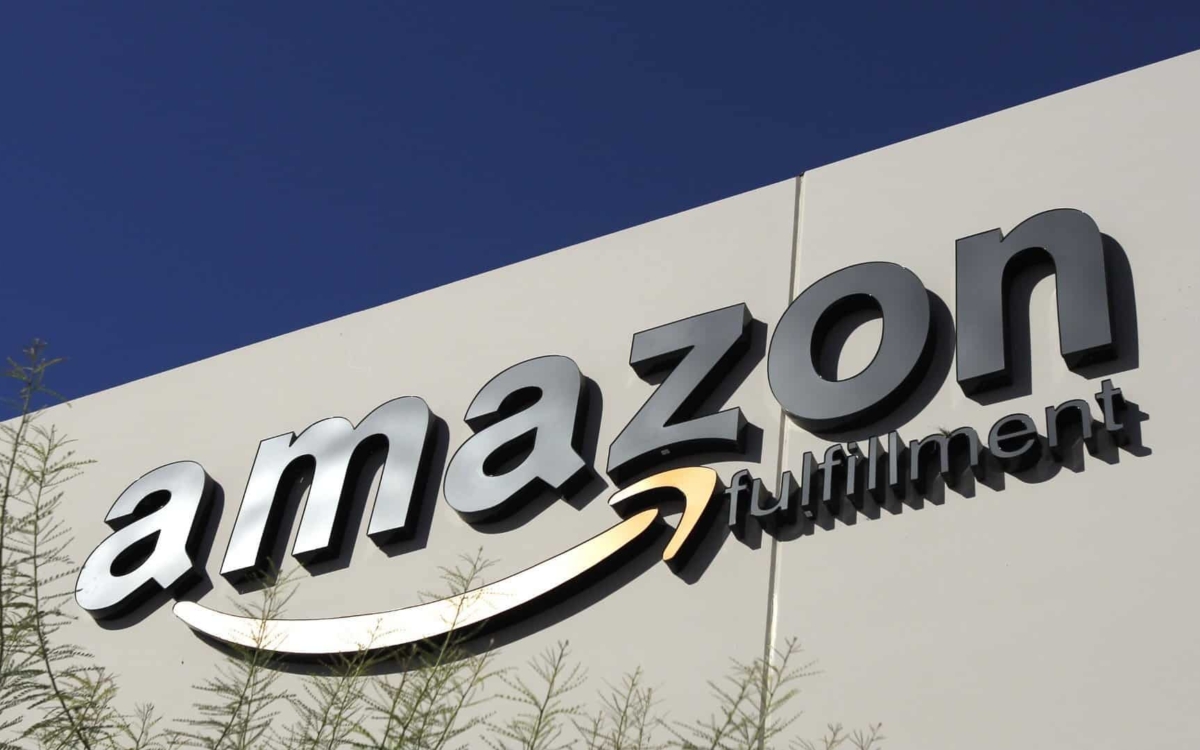
When you buy something through one of the links on our site, we may earn an affiliate commission.
Going back to the beginning, Spencer's Amazon business has now eclipsed $800,000 in total revenue. While we've done some private label products, the vast majority of that revenue has come from creating our own unique products and selling them through Amazon's FBA program.
Today I want to share some insight into how we come up with product ideas and hopefully help you take the leap towards creating your own product.
What Do You Mean By “Unique”?
I'm really glad I asked myself this question.
For the purposes of this article, I just mean that the product is unique to Amazon. So that technically could be a product that is sold other places and probably would sell on Amazon, but nobody is selling it there currently.
More commonly, our approach is to find products that already do sell well on Amazon and then add/change things that give us at least one unique selling feature so our product isn't just a carbon copy of other things out there.
Ideally, we want to find some evidence that people would actually want to buy our unique version of the product. In this article I'll be sharing details of how we do that.
What To Sell On Amazon
Below I give you some ideas for how to come up with unique product ideas to sell on Amazon. This will keep you from being a carbon copy of everyone else and will give you a unique selling proposition to your product.
So here's what you can do to find the best products to sell on Amazon:
- Listen to buyer feedback on similar products
- Find ideas off of Amazon – look for products with 4 stars and improve them
- Take DIY solutions and turn them into a product
- Find products sold in other places that aren't on Amazon
- Use Amazon's suggested searches
- Scratch your own itch – make products that you want and need
How To Come Up With Unique Product Ideas For Amazon
As the old saying goes, there is no reason to re-invent the wheel. But that doesn't mean you can't and shouldn't make a wheel that looks better, lasts longer, or meets a demand that is currently underserved.
When it comes to creating products to sell on Amazon, we don't really think of ourselves as “inventors.” We're mostly looking for simple modifications to uncomplicated products that we can launch, market, and sell (and so using best product research tools for Amazon sellers helps avoid costly mistakes).
One of the best ways to get the ideas flowing is to start reading reviews online.
1. Listen to Buyer Feedback
Many times, you'll find some absolute gold inside of negative customer reviews on Amazon and elsewhere. Even in some cases when people like the product, they'll throw in suggestions like:
“it would be even better if it could…”
“The only thing I would change/add…”
“I would have given 5 stars if it…”
One way to do this quickly is to scroll down to product reviews on Amazon and click the link to view all reviews. From there, you have a search box where you can look for keywords in the reviews that might go along with this kind of feedback.
Below, I was looking at a grill cover and searched the hundreds of reviews for the word “wish” and found some useful ideas about how I might make a better grill cover:
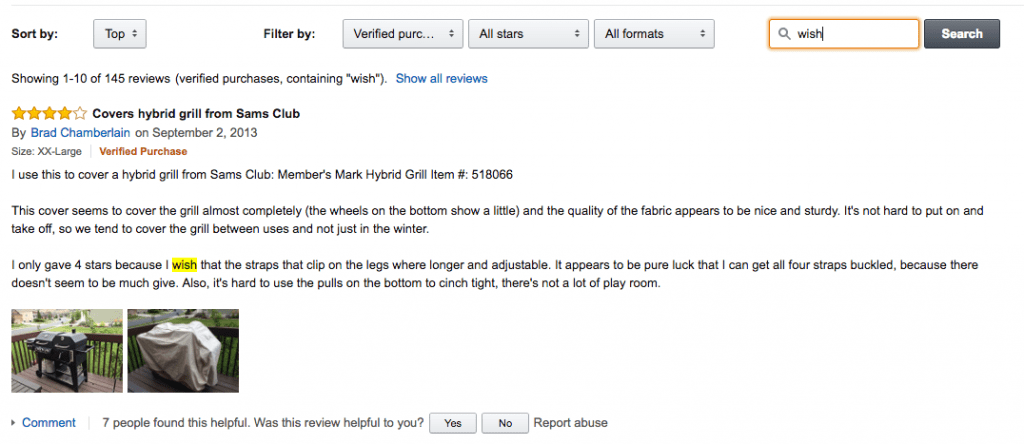
Other searchable words could be “Suggestion”, “Better”, “Improvement”, and anything else you can think of.
It's a good idea to avoid the 5 star reviews and the 1 star reviews. I like to glance at the 2 through 4 star reviews, but the 4 stars are my favorite.
These are people who love the product, but found a very real flaw to it. If you can solve that need, you have a winner.
I avoid 1 star reviews since these tend to be unhelpful, ranty, or just untrue.
2. Stack Your Ideas
Once you start finding some ideas based on buyer feedback, start making a list of possible features/improvements your product.
Personally, I like to “stack” several ideas together to give my product a number of advantages and perhaps unique features compared to the competition.
So for the grill cover above, I might find a better solution for straps that can clip on the legs but I'm going to keep looking through reviews of other top selling grill covers and hear what else customers are looking for.
I've found that implementing these solutions is often pretty inexpensive.
3. Find Ideas Off of Amazon
We use a tool called Jungle Scout Pro (read our Jungle Scout review here)that helps us estimate how well products are selling on Amazon, so we get a sense for what our ceiling might be if we created that product ourselves.
Below is a look at Jungle Scout data for meat claws:
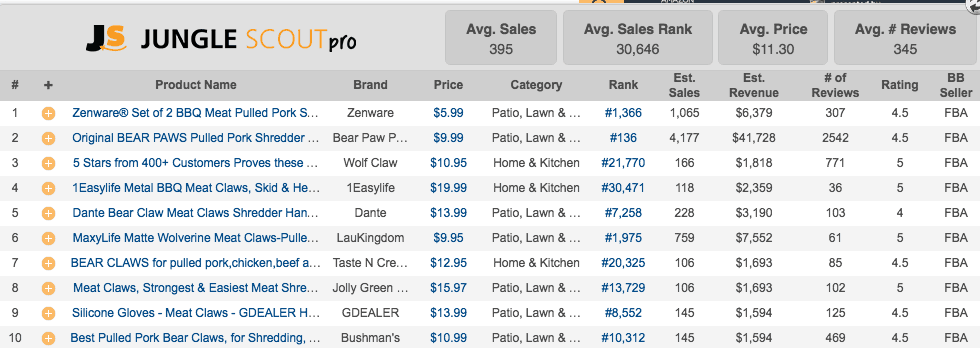
While starting by looking at what's selling on Amazon isn't a bad idea, I've also found that looking for ideas elsewhere can be super helpful.
4. Find DIY Solutions and Make A Product
DIY videos and “hacks” are everywhere. Buzzfeed is full of lists of hacks for just about every purpose, and generally you can expect to see people who have cleverly repurposed one product to make it solve an unrelated problem.
Here's an example from a Buzzfeed list of kitchen cleaning hacks where the folks at OneCrazyHouse.com used a pair of tongs and microfiber towels to clean their blinds:
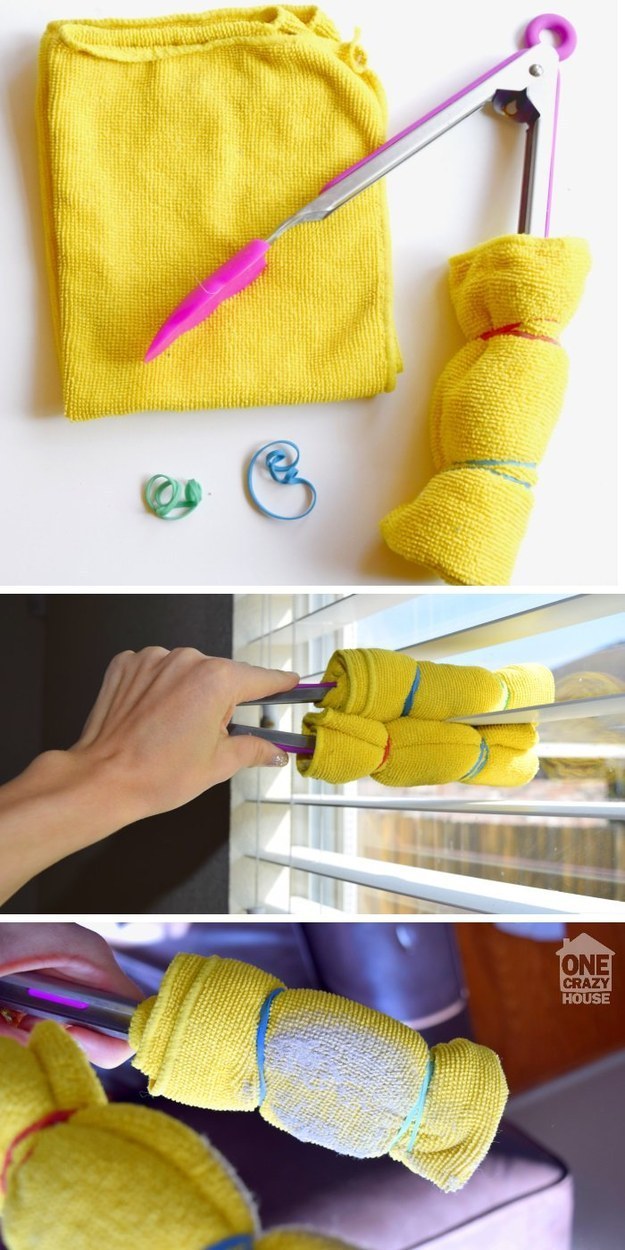
If hacks like this work well, it could be a launching point to go create and brand the best blind cleaner out there.
5. Find Products Not Sold on Amazon
Another thing I've found when just googling different solutions is products that exist, but just aren't sold on Amazon. In fact, one of our more recent successful products is based off of something I saw being sold on a sporting goods site in the UK.
While there were other products selling well on Amazon that addressed the same problem as this product, I couldn't find any products on Amazon or any US retailer that were similar to this product I found being sold in Europe.
So the market/need definitely existed in the US, and we were able to work with a manufacturer to create something similar to what we'd found selling overseas and then we became the first to launch that kind of product on Amazon US.
6. Use Amazon's Suggested Searches
If you've searched products on Amazon, you've likely noticed that like Google, they try to complete your thought for you by providing suggested searches.
These suggestions have led to some useful product ideas for us. Here is what the suggestions look like if I type “waterproof” searching all categories:
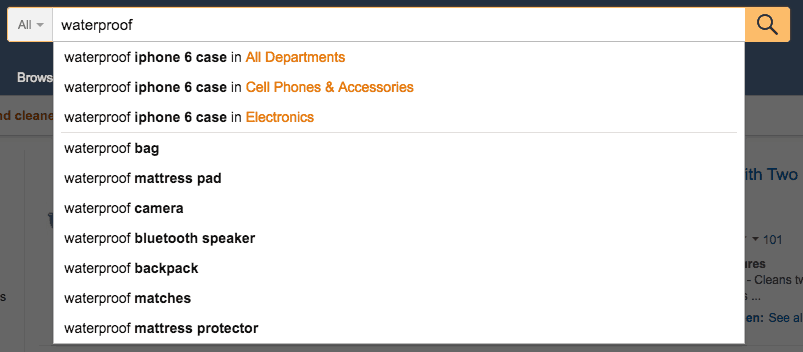
By simply looking at these suggestions I've got some product ideas that I know people are searching for.
Since “All” is the default category when you search on Amazon.com, you may not have noticed that if you change the search category the auto-complete suggestions will change to reflect that category.
Here's what “waterproof” looks like when I change the category to Home & Garden:
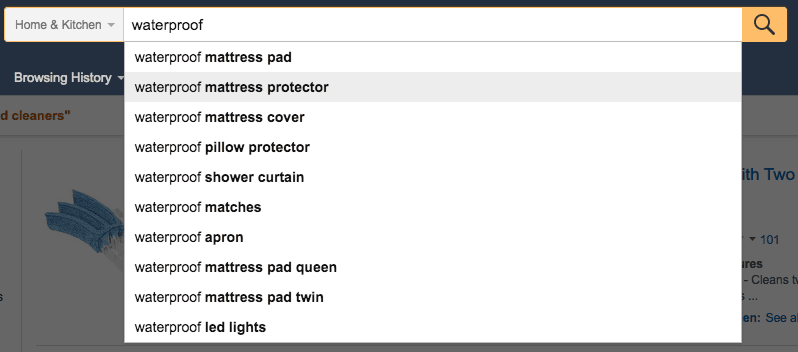
Obviously you could continue this process for different categories and start searching different words to see what comes up.
My next step is to start clicking on some of the results that sound interesting and then use Jungle Scout to see what sales look like for those products.
Let's say that “waterproof apron” seemed like a promising idea, you can then take this whole thing a step further and see suggestions for that specific product:
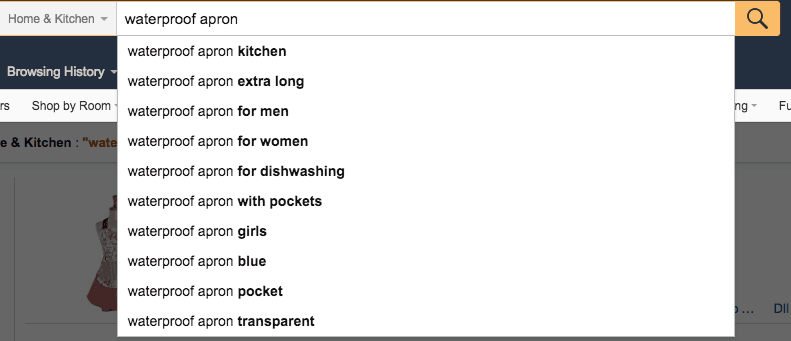
Maybe there are tons of waterproof aprons for women, but there aren't many good “extra long” waterproof aprons. That's when you'd start doing what we talked about earlier and see what reviewers are saying about the extra long aprons and see if you can figure out ways to make yours stand out from the crowd.
Maybe the other ones aren't long enough…
Maybe all the extra long aprons are focused on men and you could make a more feminine version…
Make sense?
7. Scratch Your Own Itch
They say that necessity is the mother of invention. That is, when you've got a problem you'll work hard to find a solution – even if it's a solution you have to create yourself.
Though I'm listing this idea last, maybe it should be the first place you start when brainstorming unique product ideas.
Who knows, maybe you will come up with something truly unique and patentable.
The very first product that Spencer launched on Amazon came from his own personal preferences about a common household product. He had trouble finding one that was designed to his liking, so he basically started contacting manufacturers on Alibaba who made these kinds of products already and said “I want one that looks like this ________.”
Ultimately, that lead to samples being sent, revisions being made, and a very successful product being launched a few months later.
Unless your “itch” is really weird and obscure, the odds are that other people are out there having the same problem or frustration you are – so if you can create product that works, you'll likely find others who want to buy it too.
What Can I Sell On Amazon: Why Unique Products?
There's no doubt about it, coming up with a brand new product that has unique features takes much longer than simply private labeling a product that already exists.
Besides the time it takes to come up with the idea, you then have to find a manufacturer that can actually make the product. (Hint: every manufacturer will say they can make your product).
You'll then get samples of the product, likely want some revisions and then get an updated sample before ordering.
In my experience, this process takes at least several months from idea to having a product ready to sell on Amazon.
So with all the extra work and hassle, why mess with doing a unique product?
The answer for us is that it's where the money is.
Amazon is so saturated with products that your best chance to stand out from the crowd is by having a widget that does something different.
Maybe it's a feature no one else has, maybe it's the biggest of its kind, maybe it's the smallest of its kind – you get the idea…
We've found that we can often rank for long tail searches much easier, and ultimately carve out a little niche inside of a product category by offering something your competitors do not.
But Don't You Need a Patent To Sell Unique Items On Amazon?
I don't really coach people on Amazon, but I do have casual conversations with friends and family who are interested in the business. One of the first questions I hear is “Yeah, but don't you need a patent to do that?”
(I'll stop here for my disclaimer that I'm not an attorney and this shouldn't be a substitute for legal advice.)
To many people, this whole concept is a bit intimidating and overwhelming and ultimately prevents them from ever taking action.
Here's what I've learned:
The answer is usually “no” you don't need a patent to create a new product and sell it.
Patents in the US are generally a way for someone to protect a unique function (utility) of a product, or in some cases a particular design (which is harder to defend).
For us, our primary concern isn't acquiring a patent for our own product, but rather making sure we aren't violating the patent of someone else.
There are many ‘generic' products you can create and not really worry about violating a patent. For instance, anybody can make a baseball bat. That's why there are tons of very similar bats out there in every size, color, material, etc. So if you wanted to create a new brand of baseball bat – have at it.
Although the baseball bat has been around forever, some people have made specific innovations and types of bats that are patented. One I'm familiar with is the Axe Bat which has a handle that is shaped like an axe, and not round like virtually every other bat out there. A quick Google patent search shows the patent they have on this design.
So while you could make your own brand of bat, you wouldn't be allowed to make your bat with a handle shaped like an axe.
If you're thinking about making a product that also uses a somewhat unique function you've seen elsewhere, I'd suggest doing a little Google Patent search of your own and if it's not crystal clear, getting a patent attorney to check into it and advise you if it's safe to move forward.
It's better to spend $100 upfront and have peace of mind than to purchase thousands of dollars in inventory and then find out you've got a problem.
Here's an example:
One product I was looking at making a unique variation of is this collapsible popcorn bowl. Before we went too far down the road of working on our own version of it, I noticed there weren't many other bowls out there that could collapse flat like this – which made me wonder if they had a patent on that particular functionality.
I went to Upwork and hired the services of an experienced patent attorney (for about $100) and he did a search and provided the document to show that the parent company did in fact have a patent on the utility of a bowl that would collapse flat – which was the key feature of this bowl.
Notice the distinction that this patent didn't mean we couldn't make our own popcorn bowl, we just couldn't make a collapsible one or we'd be violating their patent.
So, we simply moved onto the next idea.
(Here is a link to the patent attorney we used on Upwork, he was very fast and thorough for us.)
Wrap Up
What I've shared with you isn't by any means an exhaustive list of ideas. However, we've had a measure of success launching products on Amazon and these are some of the exact methods we've used to come up with new ideas.
My best advice is to get out there on Alibaba or even talking to a local manufacturing company where you live and at least have a conversation about what it would take to bring your sample to life.
For my last product, I literally sketched a certain kind of bag design on a piece of paper, took a picture with my iPhone, and sent it over to a bag manufacturer I had a relationship with from Alibaba. A few weeks and $120 later I had the bag I had drawn sitting in my living room.
Maybe your unique product idea won't be a homerun, but if you strike out – at least strike out swinging.
Want to learn step-by-step how I built my Niche Site Empire up to a full-time income?
Yes! I Love to Learn
Learn How I Built My Niche Site Empire to a Full-time Income
- How to Pick the Right Keywords at the START, and avoid the losers
- How to Scale and Outsource 90% of the Work, Allowing Your Empire to GROW Without You
- How to Build a Site That Gets REAL TRAFFIC FROM GOOGLE (every. single. day.)
- Subscribe to the Niche Pursuits Newsletter delivered with value 3X per week
My top recommendations

















20 Comments
Conversation
How has Amazon’s recent ban on incentives reviews affected your FBA business? I’ve heard that it turned into an arms race of more and more discounted reviews.
I know you stated quite a few times along this FBA journey that giveaway review services were a big part of launching your products. Now that Amazon has deemed these against their Terms of Service, how will you get reviews going forward? Have you seen Amazon removing/deleting past reviews that included the disclaimer by the reviewer that they received the product for free or at a discount?
Hi George – good question and a hot topic for sure! All along we’ve used SalesBacker to do email follow-up and get natural reviews, so we’ll continue that. However, for brand new products with no sales we’ve got a couple of things we’re going to try but for now we won’t be using review services to give discounts (at least until there is more clarity on how this all shakes out)
This is really helpful and great help. I really like to create my own product in the pet industry , and this give me some helpful points that I can adopt. Thanks for this
Great – glad it was helpful. Thanks for reading!
Great stuff as always!
I’ve always been curious about dealing with manufacturers when creating a new product. Since your products are not 100% original designs, is it simply a matter of telling them you want product X to be blue instead of red and 3 inches wider here, etc? Or do you provide CAD drawings with measurements and all that? I guess when I approach these guys, I don’t want to look like an amateur with my MS Paint drawing or no drawings at all if they are expected.
Ha – MS Paint… Don’t worry about looking like an amateur. We’ve had one product where we did get a CAD drawing done via Upwork because it had very specific details to it. However, generally we start with sending an image of a product that already exists (or one in their Alibaba product catalog) and use that as a starting point.
From there you can change colors, add features, etc. and by starting with a common reference point I’ve found that they have an easier time understanding what you want.
Honestly, this is a good exercise to make sure that your rep understands English well enough to “get” what you are saying. That will be important as you work through details.
Jake, thanks so much for the post. I’m thinking about Junglescout but I’ve also come across a recommendation from Spencer about Amasuite – are you guys still using it?? (www.getamasuite.com)
I like the tool and I’m thinking about both to be honest. Since it’s a small investment for a big business.
Amasuite is great as well. Both a good tools.
Hi Spencer, is there a formula you use to confirm if the market is big enough, like top 10 sales amount in Jungle Scout or what.
In some markets its obvious, top sellers doing over $10k/mth. In other markets its more difficult if you have a unique offering and there are only 1 or 2 (or none) other sellers with your unique product. Sometimes its just a gut feel. Maybe I know there is a huge market for shower heads, but what about the market size for pink showerheads? That comes down to your own analysis of the market.
Now with the new Amazon TOS is not possible to get free&discount products for reviews. Any solution other solution?
Create a better product. Use sponsored ads, lower prices, and email follow ups to drive sales and get more reviews to start.
Thanks so much for the post. Thanks Again. Awesome.
How much would you say you need to get started with this in terms of dollars?
$5k is probably a decent amount to start with.
Thanks Alot,
So this is not something for a beginner like me! Haha, I’ll start with a niche site. Thanks so much for helping, your site is a great resource.
I think Amazon offers a great opportunity with rewards but I guess you need to develop a real edge to overcome competition and it looks very time consuming unless you can devote 100% of your working life to making it happen. Worth it though if you can afford it!
Hello Spencer Haws,
I not that much new as I already tried long term and event blogging. But i failed to generate huge amount. Also there are so many risk in long term blogging as my adsense banned yesterday and i almost lost every amount. But now i am thinking to start affiliate site same as you. One of my friend referred you site to me and I am very happy that I came here.
Now I have clear idea on how to start with amazon. Thanks a lot for this great post. I have started the website and will share with you soon the results.
Congratulations thanks for the accurate information on this subject.